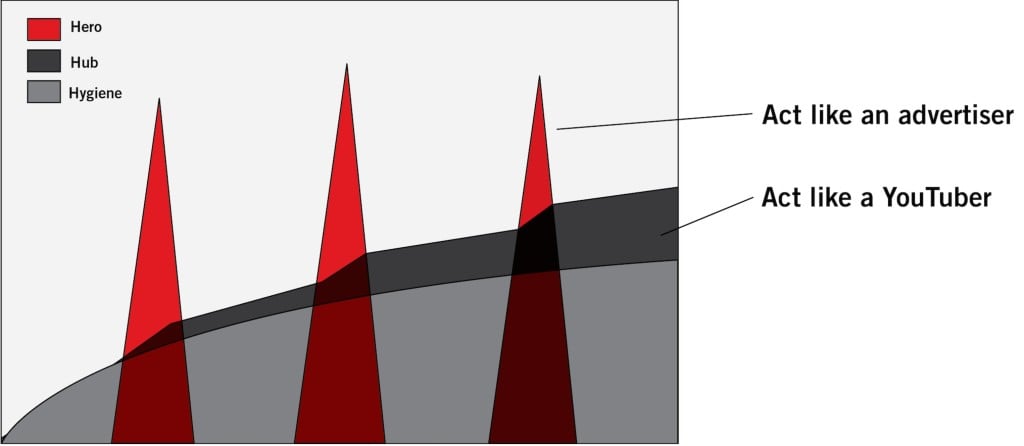Wikipedia describes the history of viral video as dating back to email distribution in 1995, and it’s probably fair to say that the idea of viral video has caught the imagination of organizations creating video many times. Who doesn’t want to create a video that will be shared millions of times for free? Yet viral video is kind of like a lightning strike, and letting the idea of it drive your video strategy will not put your organization in its most effective position. YouTube has been systematically discouraging the mindset that focuses on viral video of late, for example in the YouTube Creator Handbook for Brands which refers to Hero, Hub, and Hygiene videos.
Viral video has a more strategic substitute
 The idea of hero, hub and hygiene content calls attention to the idea of balancing your inspiring storytelling videos, the ones you might think of as having the opportunity to become viral videos, with more functional video content.
The idea of hero, hub and hygiene content calls attention to the idea of balancing your inspiring storytelling videos, the ones you might think of as having the opportunity to become viral videos, with more functional video content.
“Hero” content, which includes most viral video, is the kind your organization can only generate 1-2 times a year; it might have the opportunity to draw a big audience, like a clever launch or campaign video.
Hygiene content is geared to common online searches. It often pops up with searches that start with “how do I….” These kinds of videos can occasionally be viral videos, but most people only look at them when they have a specific need for information. If your organization or business has video possibilities that fit into this category, it’s a great idea to do them. They can also be very affordable to produce.
Hub content releases regularly and has a particular editorial voice. This post about rapid response video provides some options for developing such content.
Hygiene content and hub content can get lost in the shuffle because they are less glamorous than hero content, but in fact they are the backbone of an effective video strategy. Brendan Gahan has an interesting post that argues that viral video strategy looks a lot like the traditional ad production model, in which brands invest heavily in an expensive video instead of investing in many videos. He created the graphic shown here to relate each kind of content to a year in your video strategy. Hub content kind of ebbs and flows; hygiene content always creates background and therefore hits for your YouTube channel; hero content has a chance to become viral video so you put the kind of resources into it that you can only afford 1-3 times a year. Mr. Gahan spoke at the Reel SEO Summit in July; the event brings together the foremost influencers in video marketing, video advertising, video commerce and video analytics for a two day summit.
Good hub content puts a MiniMatters client on track to win regular viewers
We increasingly see our clients in the nonprofit and association world embracing the kind of multi-faceted approach that hero, hub, and hygiene encapsulates. The video below, which MiniMatters produced for the Orthopaedic Research and Education Foundation (OREF), exemplifies the kind of video that makes good hub material:
The video articulates a key point about OREF’s ability to make a difference in people’s lives that the organization wants to make on a regular basis. It probably has little chance of becoming a viral video that garners millions of views, but it has an important message and it’s part of a video strategy in which OREF continues to build a YouTube channel with a good number of videos to get and keep viewers and subscribers. We believe that the organization will continue to reap benefits from sharing this video and others with key stakeholders and potential donors.
If MiniMatters can help you with business video, fundraising video, association video, or other video production needs, we’d love to provide an estimate through our online form, talk with you at 301-339-0339, or communicate via email at [email protected]. We serve associations, foundations, nonprofits, and businesses primarily in Washington, DC, Maryland, and northern Virginia.

